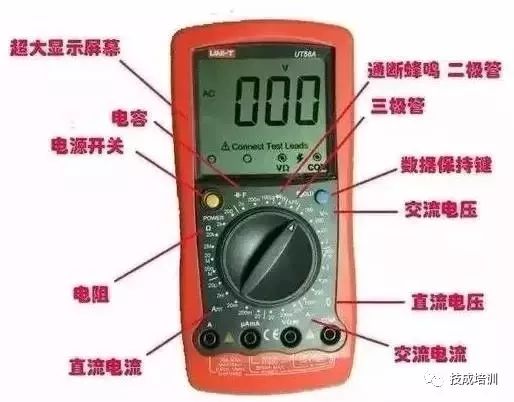
To avoid damage to the multimeter, please pay attention to the following points.
1. Most digital multimeter damages are caused by incorrect measurement range settings. For example, when measuring AC mains voltage, if the measurement range is set to resistance, the moment the probe contacts the mains, it can instantly damage the internal components of the multimeter. Therefore, always check the measurement range before using the multimeter. After use, set the measurement selection to AC 750V or DC 1000V, so that no matter what parameter is mistakenly measured next time, it will not cause damage to the digital multimeter.
2. Some digital multimeter damages are caused by measuring voltage or current that exceeds the range. For instance, measuring mains voltage in the AC 20V range can easily damage the AC amplification circuit of the multimeter, causing it to lose its AC measurement function. When measuring DC voltage, exceeding the measurement range can also easily cause circuit failure. When measuring current, if the actual current exceeds the range, it generally only causes the internal fuse of the multimeter to blow, without causing other damage. Therefore, when measuring voltage parameters, if the approximate range of the voltage is unknown, first set the measurement range to the highest setting, measure its value, and then switch to a lower range for more accurate readings. If the voltage to be measured greatly exceeds the maximum range of the multimeter, a high-resistance probe should be used.
3. The upper limit range for DC voltage on most digital multimeters is 1000V, and for AC voltage, it is 750V. Therefore, as long as the voltage measured is below the upper limit range of the multimeter, it generally will not cause damage. Exceeding the multimeter’s upper limit range can very likely cause damage.
4. Do not measure voltage in current, resistance, diode, or continuity modes. Do not rotate the function switch while testing, especially under high voltage and high current conditions.
5. When using the multimeter’s resistance setting to check the quality of components or measure component resistance in a circuit, the circuit must not be powered. This is because the resistance setting uses the internal battery of the multimeter, and if the circuit is powered, it can easily damage the internal battery and affect measurement accuracy. If the multimeter resistance setting has a fuse, it can also easily damage the equivalent resistance of the resistance setting.
6. When the battery symbol appears on the screen, it indicates low power and should be replaced. After each measurement, the multimeter should be turned off. Whether in use or storage, avoid moisture and water ingress.

To avoid possible electric shock and personal injury, please follow these rules:
1. Do not use a damaged instrument. Check the instrument’s casing before use, and pay attention to the insulation near the connection sockets.
2. Check the test probes for damaged insulation or exposed metal, check the continuity of the probes, and replace any damaged probes before using the instrument.
3. Do not use the instrument if any abnormalities occur during operation, as protection may be damaged. If in doubt, send the instrument for repair.
4. Do not use this instrument near explosive gases, vapors, or dust.
5. Do not input voltage exceeding the rated voltage indicated on the instrument between any two terminals or between any terminal and ground.
6. Before use, measure a known voltage to verify the instrument.
7. When measuring current, turn off the power to the circuit before connecting the instrument.
8. When repairing the instrument, only use specified replacement parts.
9. Be particularly cautious when measuring AC voltages of 30V RMS, 42V peak, or DC voltages above 60V, as these voltages can pose a shock hazard.
10. When using test probes, keep your fingers behind the probe’s finger guard.
11. When measuring, connect the common test probe (black probe) first, then connect the live probe (red probe); when disconnecting, disconnect the live probe first, then the common probe.
12. When opening the battery compartment, remove all test probes from the instrument.
13. Do not use the instrument if the battery compartment or instrument casing is not tightly closed or is loose.
14. When the low battery indicator ” ” appears, replace the battery as soon as possible to avoid misreading and potential electric shock or injury.
15. Do not use the multimeter to measure voltages outside the CAT classification level indicated on the multimeter.
Share with friends to gain knowledge
ClickRead Original to learn about electrical engineering, PLC, variable frequency servo, CNC robots, and more.